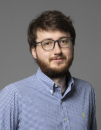Complex Networks
Data is displayed for academic year: 2023./2024.
Lecturers
Exercises
Course Description
The course is an introduction to the science of complex networks and their applications. Topics to be covered include the graph theory, data analysis, and applications to biology, sociology, technology, and other fields. Students will learn about the ongoing research in the field, and ultimately apply their knowledge to conduct their own analysis of a real network data set of their choosing as part of the final project.
Study Programmes
University graduate
[FER3-HR] Audio Technologies and Electroacoustics - profile
Elective Courses
(1. semester)
(3. semester)
[FER3-HR] Communication and Space Technologies - profile
Elective Courses
(3. semester)
[FER3-HR] Computational Modelling in Engineering - profile
Elective Courses
(3. semester)
[FER3-HR] Computer Engineering - profile
Elective Courses
(3. semester)
Elective Courses of the Profile
(3. semester)
[FER3-HR] Computer Science - profile
Elective Courses
(3. semester)
[FER3-HR] Control Systems and Robotics - profile
Elective Courses
(3. semester)
[FER3-HR] Data Science - profile
Elective Courses
(3. semester)
Elective Courses of the Profile
(3. semester)
[FER3-HR] Electrical Power Engineering - profile
Elective Courses
(3. semester)
[FER3-HR] Electric Machines, Drives and Automation - profile
Elective Courses
(3. semester)
[FER3-HR] Electronic and Computer Engineering - profile
Elective Courses
(3. semester)
[FER3-HR] Electronics - profile
Elective Courses
(3. semester)
[FER3-HR] Information and Communication Engineering - profile
Elective Courses
(3. semester)
Elective Coursesof the Profile
(3. semester)
[FER3-HR] Network Science - profile
Core-elective courses
(3. semester)
[FER3-HR] Software Engineering and Information Systems - profile
Elective Courses
(3. semester)
Learning Outcomes
- Explain basic concepts of complex networks
- Apply the knowledge gained to real networks
- Analyze data gathered from social networks
Forms of Teaching
Lectures
Lectures
ExercisesCoding tutorials
Grading Method
| Continuous Assessment | Exam | |||||
|---|---|---|---|---|---|---|
| Type | Threshold | Percent of Grade | Threshold | Percent of Grade | ||
| Attendance | 10 % | 20 % | 10 % | 20 % | ||
| Final Exam: Written | 0 % | 80 % | ||||
| Exam: Written | 0 % | 80 % | ||||
Week by Week Schedule
- Definition, Terms
- Erdos-Renyi random graphs, tree structure, giant component, Small-world (Watts-Strogatz) model
- Degree distributions
- Clustering
- Algorithms for computing degree distributions and clustering coefficients
- Network growth, preferential attachment, Barabasi-Albert model, power-law networks
- Centrality
- Not held
- Extremal paths and breadth-first search, maximum flows and minimum cuts, spanning trees
- Graph partitioning, community detection
- Spectral properties of adjacency matrix
- Structure of social network graphs
- Social network analysis
- Social network analysis
- Not held
Literature
(.), Network Science, Albert-László Barabási,
(.), Networks – an Introduction, Mark Newman, Oxford University Press,
For students
General
ID 252364
Winter semester
5 ECTS
L0 English Level
L1 e-Learning
30 Lectures
0 Seminar
12 Exercises
0 Laboratory exercises
0 Project laboratory
0 Physical education excercises
Grading System
86 Excellent
74 Very Good
62 Good
50 Sufficient


 Pristupačnost
Pristupačnost



